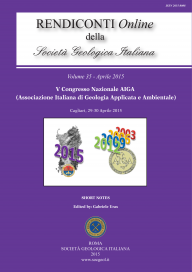
Cosesimic liquefaction phenomena from DInSAR after the May 20, 2012 Emilia earthquake
Matteo Albano (a-b), Michele Saroli (b), Giuseppe Modoni (b), Marco Chini (c), Marco Moro (a), Christian Bignami (a), Luca Pulvirenti (d), Nicola Pierdicca (d), Emanuela Falcucci (a), Stefano Gori (a) & Salvatore Stramondo (a)
(a) Istituto Nazionale di Geofisica e Vulcanologia, Via di Vigna Murata, 605, 00143, Rome, Italy. E-mail: matteo.albano@ingv.it
(b) DiCEM – Departement of Civil and Mechanical Engineering, University of Cassino and Southern Lazio, 03043, Cassino, Italy.
(c) Luxembourg Institute of Science and Technology, 5 avenue des hauts-fourneaux, L-4362, Esch-sur-Alzette, Luxembourg.
(d) Dept. of Information Engineering, Electronics and Telecommunications, Sapienza University of Rome, 00184, Rome, Italy.
Volume: 35/2015
Pages: 5-9
Abstract
In this paper, we have investigated the capability of Differential Interferometry Synthetic Aperture Radar (DInSAR) technique to detect the ground effects induced by liquefaction phenomena occurred during the May 20, 2012 Emilia earthquake. To this aim, a set of COSMO-SkyMed (CSK) SAR images covering the coseismic phase has been used. The detected surface effects have been related to liquefaction of deep sandy layers. Thanks to the geological/geotechnical data in the area and a liquefaction susceptibility analysis of the subsoil, it has been identified a sandy layer between 9 and 13 m in deep, which probably liquefied during the earthquake. The estimated vertical displacements due to liquefaction are comparable with the values measured by DInSAR.
Keywords
Get Full Text